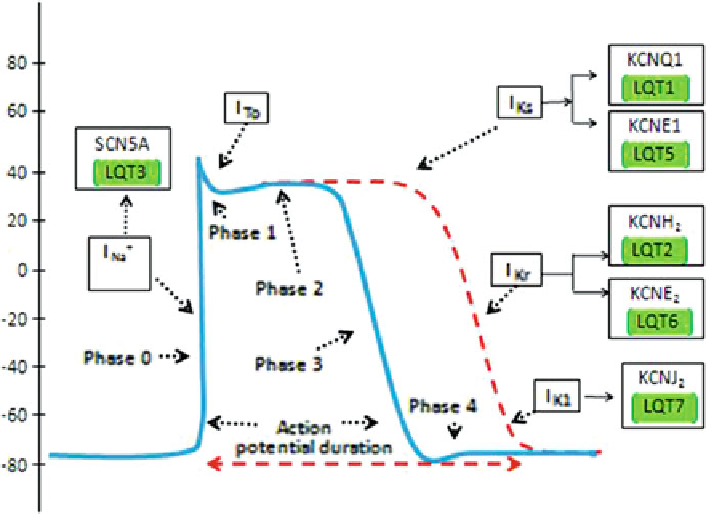Biomedical Engineering Reference
In-Depth Information
Fig. 4 Schematic diagram of a ventricular action potential showing effects of long QT syndrome
by pharmacological inhibitors of voltage-gated K
+
channel 7.1 (K
v
7.1; also known as KCNQ1) or
K
v
11.1 (also known as
hERG
or KCNH2) on action potential duration by alteration of the different
gene, which alters the ion channel currents, in different phases (0, 1, 2, 3 and 4)
life-threatening ventricular tachyarrhythmia, in particular
Tdp
. Cardiac repolariza-
tion is a complex physiological process terminating the cardiac action potential and
it results from the activities of multiple membrane ion channels and transporters.
These ion channels and transporters interact through membrane potential and
intra/or extra-cellular ionic concentrations, but are also affected by systemic factors
including hormone regulation, metabolic state and autonomic nervous tone.
Prolongation of action potential can result from inhibition of one or more of
outward K
+
currents or by increasing inward currents (Na
+
or Ca
2+
). Since IK
r
plays a key role in repolarization of cardiac action potential, selective inhibition of
this current slows repolarization and this is manifested as a prolongation of the QT
interval on the ECG (Figs.
3
and
4
). It is now widely accepted that the blockade of
IK
r
current by drugs is at least in part responsible for their proarrhythmic effect;
however, this risk may be modulated by blocking other channels [
46
]. The spectrum
of drugs associated with
Tdp
involves antiarrhythmic drugs, non-antiarrhythmic
cardiovascular drugs and non-cardiovascular drugs (Table
1
). Only 26% cases were
associated with cardiac agents out of the 2,194 cases reported to the American Food
and Drug Administration regarding
Tdp
. The other drug classes with proarrhythmic
adverse effects are central nervous compounds comprising 22%, antiinfectives 19%
and antihistamines 12%. Class-III antiarrhythmic drugs such as sotalol, dofetilide

